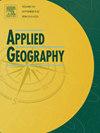Effects of air pollution and greenspace exposure on cause-specific mortality among older adults in Guangzhou, China
IF 5.4
2区 地球科学
Q1 GEOGRAPHY
引用次数: 0
Abstract
In light of increasing recognition of the detrimental impacts of air pollution and beneficial impacts of greenspace on public health, limited research has examined how greenspace modifies air pollution-related mortality risks in high-density urban contexts in China. This study utilized Guangzhou death registration data (2017–2019) and negative binomial regression models to evaluate the effects of PM2.5, PM10, and NO2 concentrations and NDVI on non-accidental, cardiovascular, and respiratory mortality among adults aged 60 and over across 2774 neighborhoods. Results indicate that non-accidental mortality risk rose by 5.6 % (95 % CI: 3.5 %, 7.6 %), 2.7 % (95 % CI: 1.8 %, 3.5 %), and 14.7 % (95 % CI: 9.6 %, 20 %) for every 1 μg/m3 increase in PM2.5 and PM10 concentrations and 1 ppbv increase in NO2 concentration, respectively. Similar trends were found for cardiovascular and respiratory mortality, with the strongest effects observed for respiratory mortality. Higher greenness mitigated the impact of PM on respiratory mortality but exacerbated the adverse effects of NO2 on cardiovascular mortality. Stratified analyses showed stronger effects of air pollution and greenspace among females and disadvantaged neighborhoods. These findings highlight the need to integrate air pollution control and greenspace system planning into urban environmental health interventions to reduce mortality risk, particularly in high-density urban areas and among vulnerable populations.

空气污染和绿地暴露对中国广州老年人死因特异性死亡率的影响
鉴于人们越来越认识到空气污染的有害影响和绿色空间对公共健康的有益影响,有限的研究调查了中国高密度城市环境中绿色空间如何改变空气污染相关的死亡风险。本研究利用广州市2017-2019年死亡登记数据和负二项回归模型,评估了PM2.5、PM10和NO2浓度以及NDVI对2774个社区60岁及以上成年人非意外死亡率、心血管死亡率和呼吸系统死亡率的影响。结果表明,PM2.5和PM10浓度每增加1 μg/m3, NO2浓度每增加1 ppbv,非意外死亡风险分别增加5.6% (95% CI: 3.5%, 7.6%)、2.7% (95% CI: 1.8%, 3.5%)和14.7% (95% CI: 9.6%, 20%)。心血管和呼吸系统死亡率也发现了类似的趋势,呼吸系统死亡率的影响最大。较高的绿化程度减轻了PM对呼吸道死亡率的影响,但加重了NO2对心血管死亡率的不利影响。分层分析显示,空气污染和绿地对女性和弱势社区的影响更大。这些发现突出表明,需要将空气污染控制和绿色空间系统规划纳入城市环境卫生干预措施,以降低死亡风险,特别是在人口密集的城市地区和脆弱人群中。
本文章由计算机程序翻译,如有差异,请以英文原文为准。
求助全文
约1分钟内获得全文
求助全文
来源期刊

Applied Geography
GEOGRAPHY-
CiteScore
8.00
自引率
2.00%
发文量
134
期刊介绍:
Applied Geography is a journal devoted to the publication of research which utilizes geographic approaches (human, physical, nature-society and GIScience) to resolve human problems that have a spatial dimension. These problems may be related to the assessment, management and allocation of the world physical and/or human resources. The underlying rationale of the journal is that only through a clear understanding of the relevant societal, physical, and coupled natural-humans systems can we resolve such problems. Papers are invited on any theme involving the application of geographical theory and methodology in the resolution of human problems.
 求助内容:
求助内容: 应助结果提醒方式:
应助结果提醒方式:


